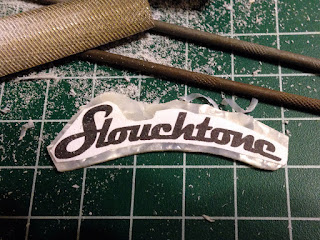While the lacquer on the guitar was curing I got to work on the the neck. The first thing I needed to do was reshape the headstock. The kit part was flat across the top but I wanted it to have the same shape as the Gibson.
I found a drawing of a Gibson headstock online. The geometry of the drawing was different than that of the kit part but I only cared about the width of the curve at the top. I resized the image in Photoshop to be slightly wider than the kit headstock. I printed the drawing and glued it to a thin piece of scrap wood. This was to be used as the jig to guide the router during the cut. The jig would hit the collar around the router bit allowing the bit to only cut the wood up to the jig.
 |
| The printout laminated to a thin board |
Using a band saw I cut out the shape as close as I could. The humps at the top of the curve were not quite symmetric but it was close enough.
 |
| The jig after cutting on the bandsaw |
To use the hand router like a table router, I turned the router upside down so the router bit was pointing up. This way I could move the small piece of wood against the bit. To keep the router from bouncing all over the bench, my father held it down while I moved the jig.
After clamping the jig to a piece of scrap wood, I did a test cut. The test worked so I attached the jig to the headstock. Since there were to be no do-overs I triple-checked the positioning of the jig and crammed it into the router. The system worked for a second time, but since I was cutting end grain the results were a bit more rough than my initial test.
 |
| The test cut |
 |
| The initial cut to the headstock. Note the lovely glue spot. |
Also, since the blade was spinning clockwise into the wood, there was some splintering on the left most side of the cut. What I should have done was stop cutting when I got to the middle, flip the jig over to the other side of the headstock and cut the other half. This way the router bit would have always been spinning toward the center of the headstock.
 |
| The rough edges in the end grain |
The router bit was too fat to fit into the pointiest part of the V in the center of the jig. I cleaned this up with files.
 |
| The final shape after filing and reshaping |
While irritating, the splintering was not too bad. I glued and clamped the cracked bits back into place. Later I piled on the wood putty to fill the ragged end grain.
 |
| The damage glued and puttied |


















































